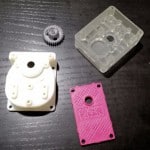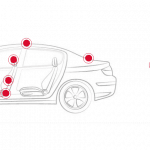When speaking of actuators or moving mechanisms in the automotive industry, headlights and lighting systems are an unavoidable topic. Static headlights with light bulbs are now a thing of the past. Nowadays, manufacturers do their best efforts to improve driving comfort, and in this regard, automatic adaptive headlights are increasingly gaining ground. Do you know how those motions are achieved? And which benefits they offer when driving?
1. They allow for safer driving
Automatic adaptive headlights is one of the innovations of automotive engineering that is destined to improve driving safety. These systems allow automatic lighting on the road without the need for driver interaction. The usefulness of these adaptive headlights involves the all-important task of preventing accidents.
Imagine you are driving at night along a two-lane road with no lighting, and you approach a curve. Even if you are driving at the proper speed, visibility is reduced. Thanks to these adaptive headlights, lights automatically rotate depending on the angle of rotation of the steering wheel on every curve, offering a better visibility over the road ahead. In 2006, for example, over 46% of fatal accidents took place at night. Adaptive headlamps enhance the night driving experience, making the trip safer.
2. They avoid blinding other vehicles or pedestrians
Adaptive headlights not only benefit the driver, but also other vehicles. For example, if travelling along a two-way sloped road, the light pattern is reduced to prevent glare on oncoming drivers.
3. They adapt better to driving conditions
Automatic adaptive headlights have high and low beams which are automatically adjusted by a set of sensors. Next, information is sent to a computer regarding driving conditions and traffic. They have systems that are capable of detecting oncoming traffic and the taillights of cars in front of us. Based on this information, headlights are automatically turned on. The driver will be able to use the highest beam without blinding other drivers.
4. They improve driving in adverse weather
Driving in the rain or fog increases road accident rates. One of the factors is lack of visibility. Adaptive headlights can help the driver even in adverse weather. For example, this type of system activates anti-fog lights, and at a rate of speed slower than 70 km/h, they rotate the left headlight about 8 degrees outwards and 1 degree down. Thus, glare in foggy weather is diminished and the left side is more illuminated.

How do adaptive headlights work?
Automatic adaptive headlights have the ability to:
1. –Auto-level
2. – Adapt to curves
3. – Detect light levels and turn on or off automatically
Leading automotive manufacturers have added this technology to their range of vehicles.
In regards to their motion, adaptive headlights can perform small horizontal or vertical motions associated to the application of gear motors in the automotive industry. These motions depend on mechanical systems which allow for the reduction of speed of a motor in a constant, efficient and safe manner.
Thanks to a variety of sensors that are connected to a computer, these headlights dynamically adjust their beam in the direction of the turn (up to 15 degrees off-centre, which provides them a 30-degree range of motion). This technology ensures a better visibility and higher safety during the night in sinuous roads.
In vehicles equipped with this technology, a low beam is activated automatically as soon as the sensor determines a specific lighting value. In other words, they improve the driving experience, preventing the driver passing through poorly lit areas from paying constant attention to adjusting the headlights.
Sensors connected to a computer to measure changes
These systems have sensors which continuously measure the steering angle, speed and vehicle rotation. With all this information, a computer activates small electric motors combined with gear motors to rotate headlights left or right. Thus, the beam faces the direction of motion. In summary, with these swivelling headlight systems, lights illuminate 30 to 60 degrees around the vehicle.
Adaptive headlights with self-levelling systems
HID headlights are much brighter than conventional halogen lights. They may stun and blind other drivers and pedestrians. This is the reason why in Europe, vehicles equipped with these headlights are required by law to have an auto-levelling system that makes sure headlights are facing down on the road.
Auto-levelling headlight technology has an additional level sensor which determines if the vehicle is leaning forwards or backwards. For example, if the car drives over a large pothole, when the front part of the vehicle hits the pothole, it rises. A standard headlight would point skywards for a few fractions of a second, until the back of the car levels itself. Therefore, the driver would not be able to see ahead for a brief instant.
Adaptive headlights with auto-levelling and electric servomotors react to the levelling sensor, and their light will always point towards the road, regardless of the vehicle compartment rising or descending.
Smart adaptive headlights
Adaptive headlight systems are becoming ever smarter. There are vehicle models which turn on the auxiliary lights in turns at speeds up to 70 km/h (sharp turns); also when turning at intersections, or during parking manoeuvers. These types of lights can illuminate up to a maximum of 80 additional degrees.
Were you aware of all the features of these systems? Gear motors are responsible for these and other motions which make driving easier for millions of people. At CLR we are experts at supplying actuators to leading Tier 1 international companies. Do you have an automotive engineering project on your hands? CLR can be your trusted partner. Tell us about your project, no strings attached.










